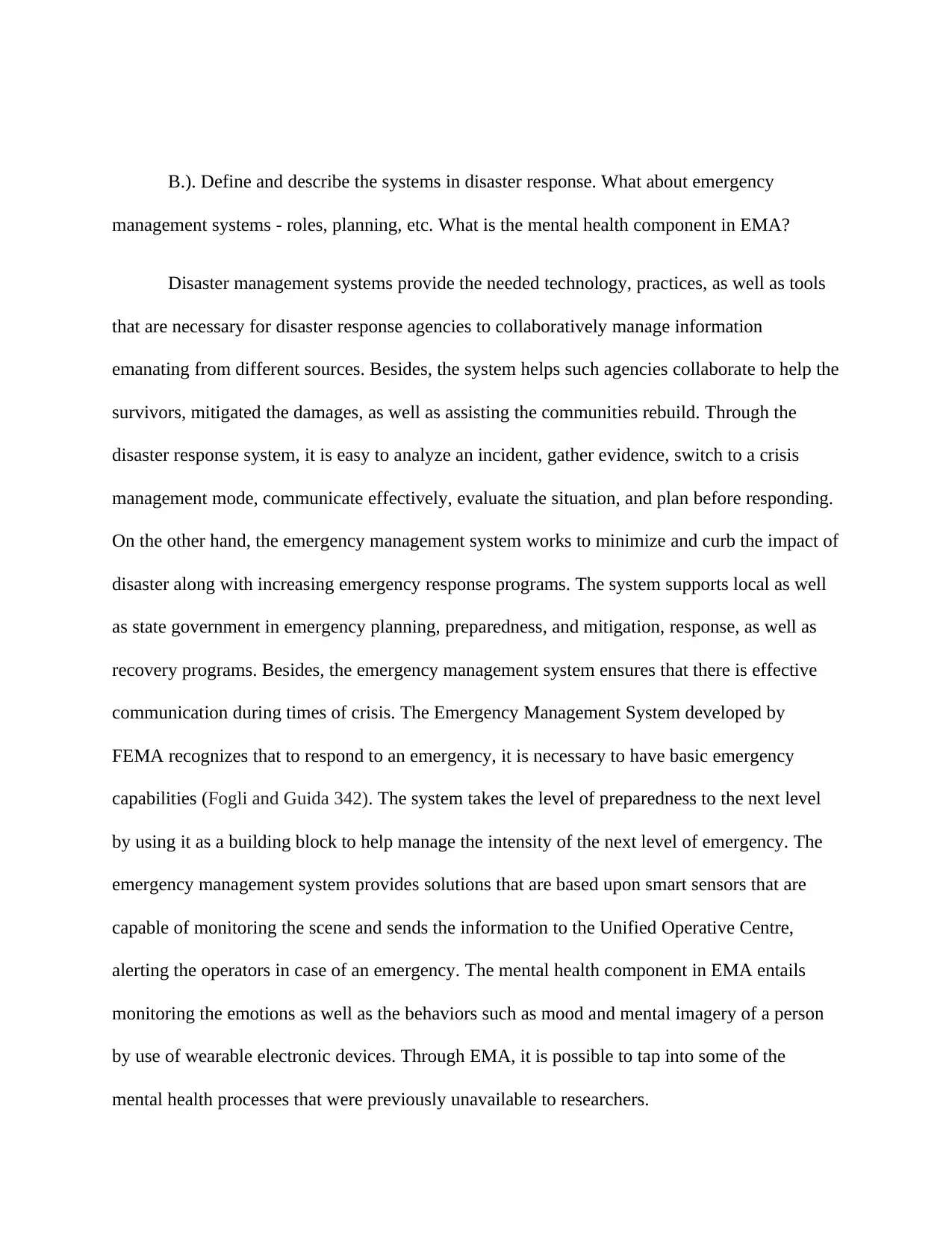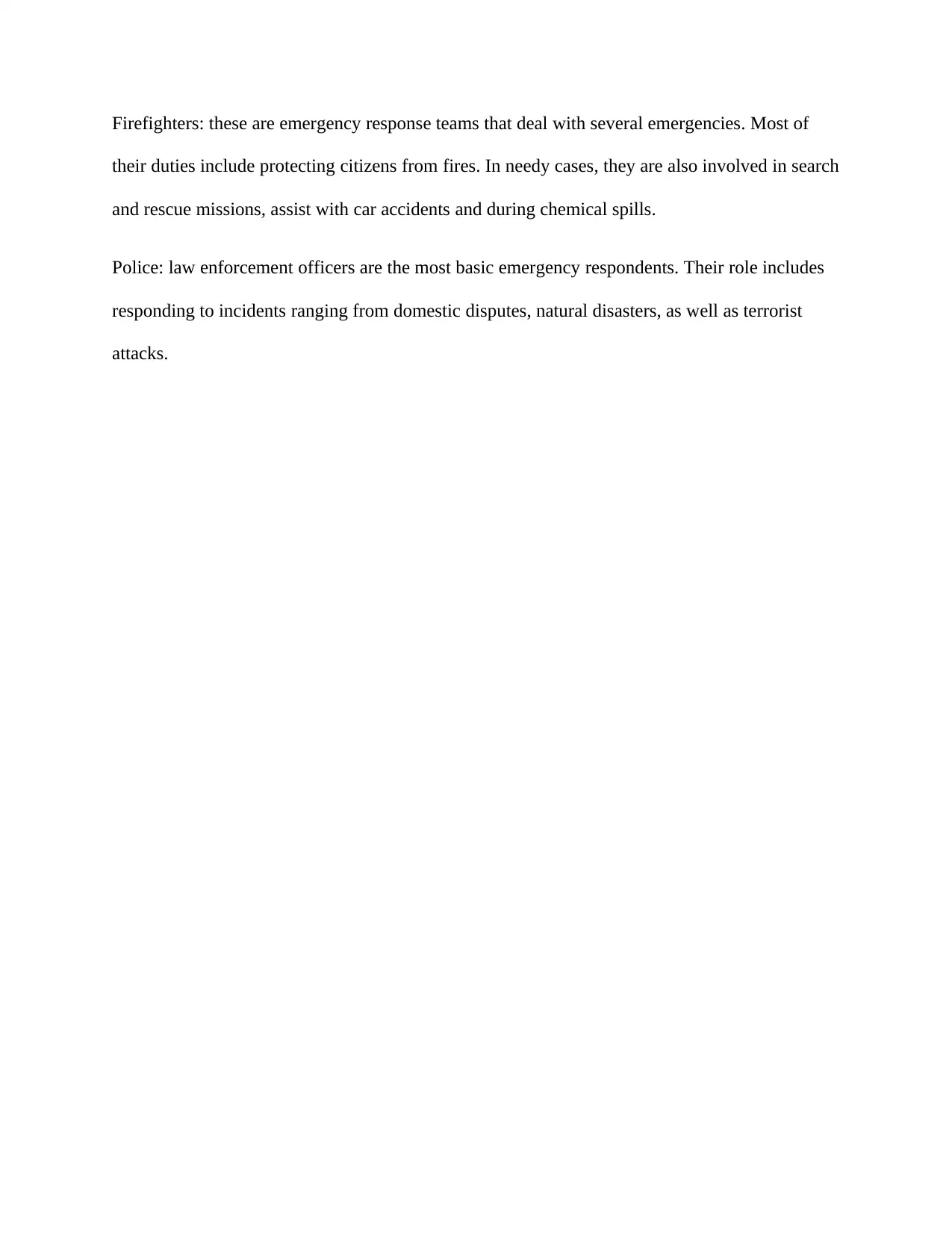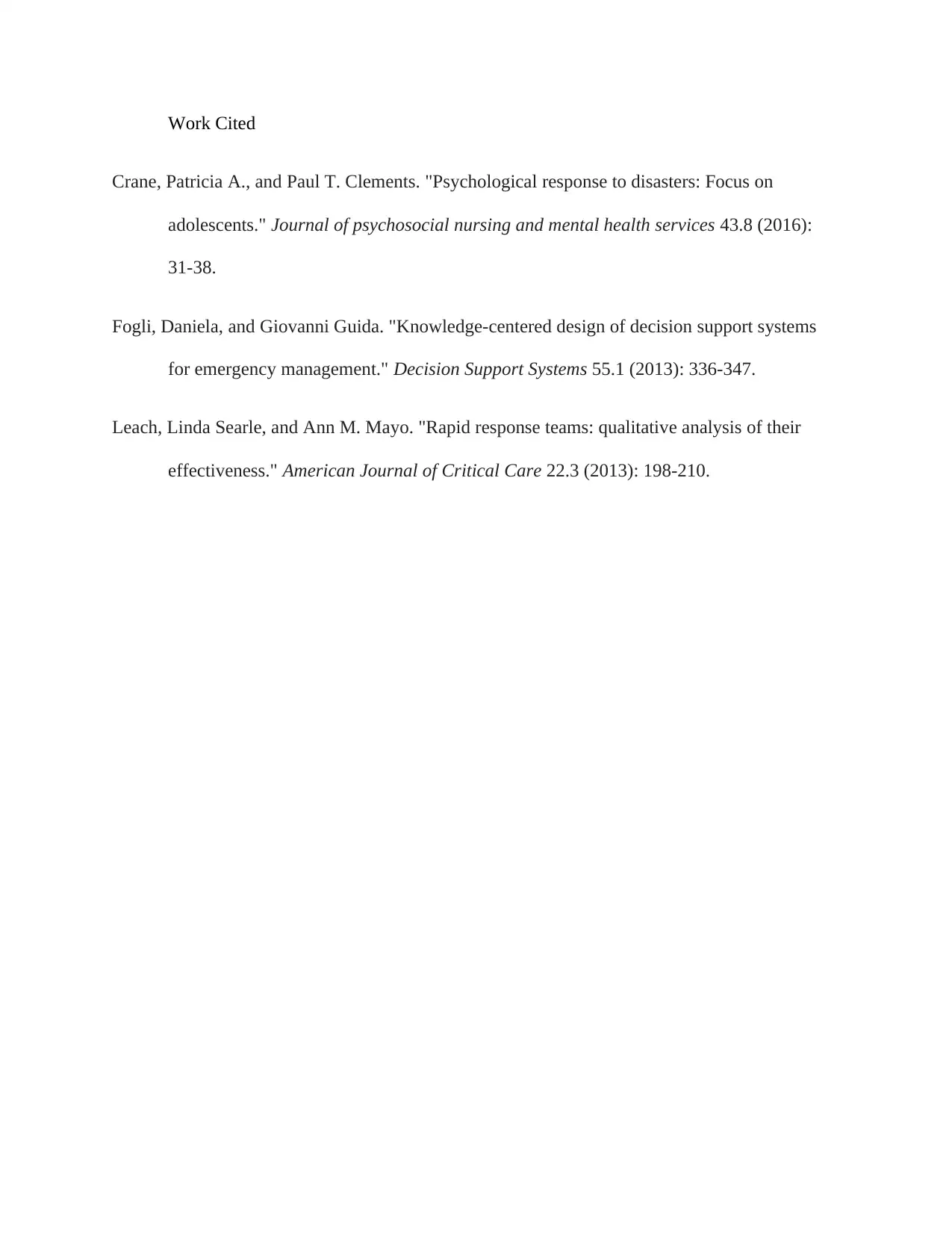Crisis Response Teams, Mental Health, and Disaster Management Analysis
VerifiedAdded on 2022/07/28
|5
|1089
|40
Homework Assignment
AI Summary
This assignment delves into the history of mental health in disaster response, exploring its evolution from ancient times to modern approaches. It examines the impact of international terrorism and human-made disasters, highlighting new directions in preparedness and technology. The document defines and describes disaster response and emergency management systems, outlining their roles, planning processes, and the mental health component within emergency management. Furthermore, it discusses various national crisis response teams, including their specific roles and responsibilities in handling diverse emergencies such as terrorism, medical crises, and natural disasters. The provided work cited section supports the assignment by including scholarly articles that contribute to the assignment's core concepts.

A.) What is the history of mental health in disaster response? What about International
terrorism and human-made disasters - what are the new directions?
Most cultures consider mental illness as a demonic possession as well as a form of
religious punishment. However, in ancient Egyptian, Greek, Indian, as well as Roman writings,
mental illness was regarded as a personal problem. In disaster response pertaining to mental
health, in the 5th century B.C., Hippocrates pioneered the treatment of mentally ill individuals
using methods that were focused on changing the environments and occupation of the patient. In
the US, mental illness persisted into the 18th century, resulting in stigmatization and unhygienic
confinement of individuals with the condition. Besides, the history of International terrorism can
be traced back to the French revolution and has since evolved. During the 1970s and the 1980s,
the USA and its partners mainly aimed at combating secular and national terrorist groups (Crane
et al. 33). With eased transnational commerce, travel, as well as communication, terrorism has
adopted this new international environment, thus calling for more measures to combat
international terrorism. The approach used in responding to emergency responding to human-
made disasters can be traced back to more than fifty years. For example, the use of
epidemiologic principles began during the massive international relief efforts in the late 1960s in
Nigeria during the civil war that resulted in massive internal displacements, increased mortality,
and starvation. Modern directions to disaster response include anticipated preparedness by
governments. The governments are using advanced disaster management technology to provide
disaster management authorities with a crucial support system during the disaster-related crisis.
Besides, these technologies also provide crucial inputs for all types of disaster management plan
of action in recent times.
terrorism and human-made disasters - what are the new directions?
Most cultures consider mental illness as a demonic possession as well as a form of
religious punishment. However, in ancient Egyptian, Greek, Indian, as well as Roman writings,
mental illness was regarded as a personal problem. In disaster response pertaining to mental
health, in the 5th century B.C., Hippocrates pioneered the treatment of mentally ill individuals
using methods that were focused on changing the environments and occupation of the patient. In
the US, mental illness persisted into the 18th century, resulting in stigmatization and unhygienic
confinement of individuals with the condition. Besides, the history of International terrorism can
be traced back to the French revolution and has since evolved. During the 1970s and the 1980s,
the USA and its partners mainly aimed at combating secular and national terrorist groups (Crane
et al. 33). With eased transnational commerce, travel, as well as communication, terrorism has
adopted this new international environment, thus calling for more measures to combat
international terrorism. The approach used in responding to emergency responding to human-
made disasters can be traced back to more than fifty years. For example, the use of
epidemiologic principles began during the massive international relief efforts in the late 1960s in
Nigeria during the civil war that resulted in massive internal displacements, increased mortality,
and starvation. Modern directions to disaster response include anticipated preparedness by
governments. The governments are using advanced disaster management technology to provide
disaster management authorities with a crucial support system during the disaster-related crisis.
Besides, these technologies also provide crucial inputs for all types of disaster management plan
of action in recent times.
Paraphrase This Document
Need a fresh take? Get an instant paraphrase of this document with our AI Paraphraser

B.). Define and describe the systems in disaster response. What about emergency
management systems - roles, planning, etc. What is the mental health component in EMA?
Disaster management systems provide the needed technology, practices, as well as tools
that are necessary for disaster response agencies to collaboratively manage information
emanating from different sources. Besides, the system helps such agencies collaborate to help the
survivors, mitigated the damages, as well as assisting the communities rebuild. Through the
disaster response system, it is easy to analyze an incident, gather evidence, switch to a crisis
management mode, communicate effectively, evaluate the situation, and plan before responding.
On the other hand, the emergency management system works to minimize and curb the impact of
disaster along with increasing emergency response programs. The system supports local as well
as state government in emergency planning, preparedness, and mitigation, response, as well as
recovery programs. Besides, the emergency management system ensures that there is effective
communication during times of crisis. The Emergency Management System developed by
FEMA recognizes that to respond to an emergency, it is necessary to have basic emergency
capabilities (Fogli and Guida 342). The system takes the level of preparedness to the next level
by using it as a building block to help manage the intensity of the next level of emergency. The
emergency management system provides solutions that are based upon smart sensors that are
capable of monitoring the scene and sends the information to the Unified Operative Centre,
alerting the operators in case of an emergency. The mental health component in EMA entails
monitoring the emotions as well as the behaviors such as mood and mental imagery of a person
by use of wearable electronic devices. Through EMA, it is possible to tap into some of the
mental health processes that were previously unavailable to researchers.
management systems - roles, planning, etc. What is the mental health component in EMA?
Disaster management systems provide the needed technology, practices, as well as tools
that are necessary for disaster response agencies to collaboratively manage information
emanating from different sources. Besides, the system helps such agencies collaborate to help the
survivors, mitigated the damages, as well as assisting the communities rebuild. Through the
disaster response system, it is easy to analyze an incident, gather evidence, switch to a crisis
management mode, communicate effectively, evaluate the situation, and plan before responding.
On the other hand, the emergency management system works to minimize and curb the impact of
disaster along with increasing emergency response programs. The system supports local as well
as state government in emergency planning, preparedness, and mitigation, response, as well as
recovery programs. Besides, the emergency management system ensures that there is effective
communication during times of crisis. The Emergency Management System developed by
FEMA recognizes that to respond to an emergency, it is necessary to have basic emergency
capabilities (Fogli and Guida 342). The system takes the level of preparedness to the next level
by using it as a building block to help manage the intensity of the next level of emergency. The
emergency management system provides solutions that are based upon smart sensors that are
capable of monitoring the scene and sends the information to the Unified Operative Centre,
alerting the operators in case of an emergency. The mental health component in EMA entails
monitoring the emotions as well as the behaviors such as mood and mental imagery of a person
by use of wearable electronic devices. Through EMA, it is possible to tap into some of the
mental health processes that were previously unavailable to researchers.

C.). Discuss the different national crisis response teams.
There are several national crisis response teams. The predefined roles of each of these
teams are filled with people that have been formally trained and are always on standby at all
times. Such teams are grouped based on ranks which are defined by the chain of command
(Leach and Mayo 201). The national crisis response teams comprised of:
Special Weapons and Tactics: the team is responsible for handling riot controls as well as
engaging in violent confrontations with criminals by the use of specialized military tactics and
equipment.
Federal Bureau of Investigations: this is the highest-ranked crisis response team in the United
States. The national team is responsible for responding to terrorist activity, national
investigations, conducting investigations on organized activities, as well as dealing with federal
offenses.
Joint Terrorism Task Force: this is a smaller team created by the FBI that is used as a front-line
defense when responding to terrorism activity in the United States. The team is located in the
entire nation and works with different organizations to gather information on possible terrorist
activities.
Emergency Medical Team: the team is responsible for providing basic medical care to citizens.
Most of the teams work for ambulance, hospitals, fire as well as police departments, and
ambulance services.
There are several national crisis response teams. The predefined roles of each of these
teams are filled with people that have been formally trained and are always on standby at all
times. Such teams are grouped based on ranks which are defined by the chain of command
(Leach and Mayo 201). The national crisis response teams comprised of:
Special Weapons and Tactics: the team is responsible for handling riot controls as well as
engaging in violent confrontations with criminals by the use of specialized military tactics and
equipment.
Federal Bureau of Investigations: this is the highest-ranked crisis response team in the United
States. The national team is responsible for responding to terrorist activity, national
investigations, conducting investigations on organized activities, as well as dealing with federal
offenses.
Joint Terrorism Task Force: this is a smaller team created by the FBI that is used as a front-line
defense when responding to terrorism activity in the United States. The team is located in the
entire nation and works with different organizations to gather information on possible terrorist
activities.
Emergency Medical Team: the team is responsible for providing basic medical care to citizens.
Most of the teams work for ambulance, hospitals, fire as well as police departments, and
ambulance services.
⊘ This is a preview!⊘
Do you want full access?
Subscribe today to unlock all pages.

Trusted by 1+ million students worldwide

Firefighters: these are emergency response teams that deal with several emergencies. Most of
their duties include protecting citizens from fires. In needy cases, they are also involved in search
and rescue missions, assist with car accidents and during chemical spills.
Police: law enforcement officers are the most basic emergency respondents. Their role includes
responding to incidents ranging from domestic disputes, natural disasters, as well as terrorist
attacks.
their duties include protecting citizens from fires. In needy cases, they are also involved in search
and rescue missions, assist with car accidents and during chemical spills.
Police: law enforcement officers are the most basic emergency respondents. Their role includes
responding to incidents ranging from domestic disputes, natural disasters, as well as terrorist
attacks.
Paraphrase This Document
Need a fresh take? Get an instant paraphrase of this document with our AI Paraphraser

Work Cited
Crane, Patricia A., and Paul T. Clements. "Psychological response to disasters: Focus on
adolescents." Journal of psychosocial nursing and mental health services 43.8 (2016):
31-38.
Fogli, Daniela, and Giovanni Guida. "Knowledge-centered design of decision support systems
for emergency management." Decision Support Systems 55.1 (2013): 336-347.
Leach, Linda Searle, and Ann M. Mayo. "Rapid response teams: qualitative analysis of their
effectiveness." American Journal of Critical Care 22.3 (2013): 198-210.
Crane, Patricia A., and Paul T. Clements. "Psychological response to disasters: Focus on
adolescents." Journal of psychosocial nursing and mental health services 43.8 (2016):
31-38.
Fogli, Daniela, and Giovanni Guida. "Knowledge-centered design of decision support systems
for emergency management." Decision Support Systems 55.1 (2013): 336-347.
Leach, Linda Searle, and Ann M. Mayo. "Rapid response teams: qualitative analysis of their
effectiveness." American Journal of Critical Care 22.3 (2013): 198-210.
1 out of 5
Related Documents
Your All-in-One AI-Powered Toolkit for Academic Success.
+13062052269
info@desklib.com
Available 24*7 on WhatsApp / Email
![[object Object]](/_next/static/media/star-bottom.7253800d.svg)
Unlock your academic potential
Copyright © 2020–2025 A2Z Services. All Rights Reserved. Developed and managed by ZUCOL.





